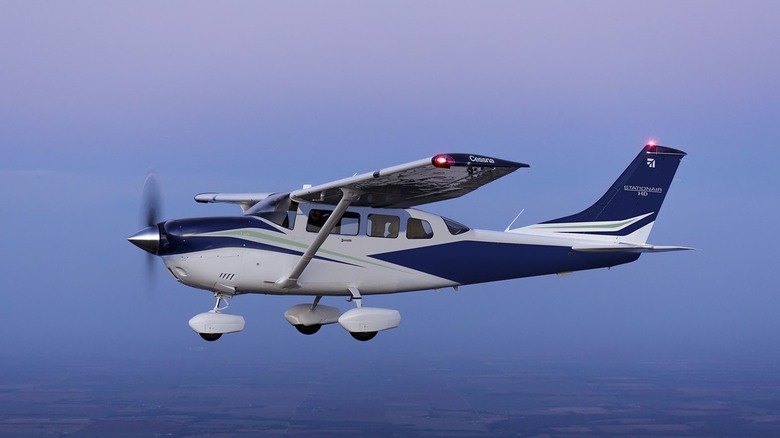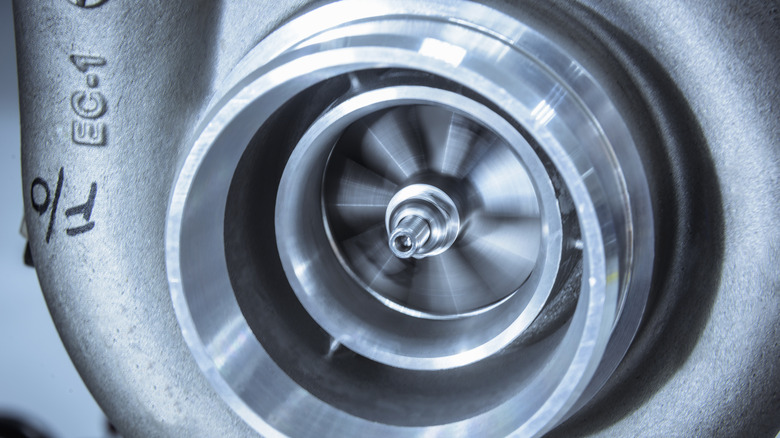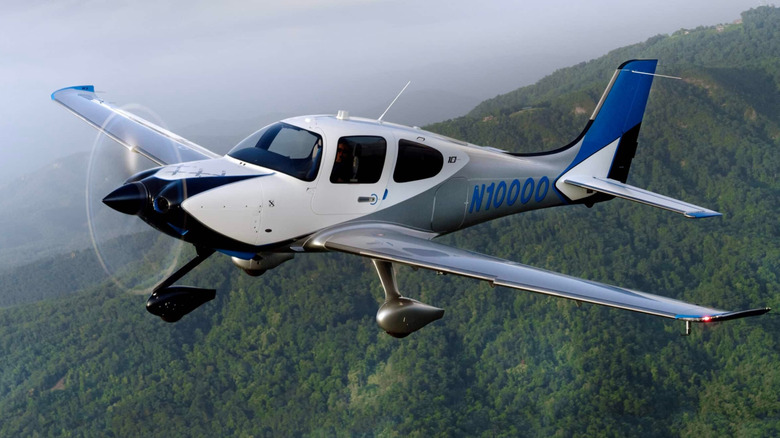Beyond Speed And Acceleration: Why Turbocharged Engines Allow Airplanes To Fly Higher
Speed, efficiency, and altitude are the name of the game when it comes to aircraft; all of which benefit from smaller engines. "There's no replacement for displacement" applies less to piston-engine planes because the bigger the engine, the more frontal cross-section impacts the wind. Drag plays a huge factor in improving aerodynamic efficiency, which is why propellers typically don't approach the speed of sound. Moreover, the higher you go, the thinner the air, which means engines have to work harder to produce the same amount of power. Pilots also have to monitor the air/fuel mixture and manifold pressure with more throttle.
Naturally-aspirated engines are only capable of going so high because of this, so how do you achieve higher altitudes? The answer is forced-induction. A turbocharger compresses air using exhaust gases to drive a turbine. This spins a secondary turbine which sucks additional air into the engine, producing multiple times the ambient air pressure. There are many methods to achieving this in both cars and aircraft, from single-turbo to sequential, twin, and even quad-turbocharged engines. However, because they're effectively compressed-air pumps, they allow engines to operate at higher altitudes without substantial power loss.
To put this into perspective, at 18,000 feet the air is 50% less dense than at sea-level, and 63% less at 25,000 feet. With the air that thin, the engine simply can't maintain an optimal mixture or high enough manifold pressure to produce good power, hence why many aircraft utilize either superchargers or turbos.
How aircraft turbos work, and which platforms use them
Aircraft piston engines largely halted further technological development following the rise of the Jet Age, leading to a comparatively archaic design against your typical car engine. While the old adage of "If it ain't broke, don't fix it" certainly applies when you're flying at altitude, there have been numerous advances through the years, such as fuel injection, better cooling systems, sustainable fuels to help replace leaded avgas, and forced induction systems.
Many such induction systems have been implemented, beginning in 1918 with the advent of the "turbosupercharger." This is an early example of a turbocharger in principle, using a turbine which is driven by the hot exhaust gases of the engine. These gases pass through an intercooler, a necessity owing to the high heat potentially causing detonation in the carburetor, before feeding into the engine itself. This leads to a dramatic increase in pressure, measured at 25,000 feet to go from 11 inches of mercury to 50. For context, standard atmospheric pressure is 29.92 inHg.
These systems evolved into aircraft equivalents to the turbos we know today, which are functionally no different to their automotive counterparts. Most piston-engine aircraft designed for high altitudes feature one or more forced-induction systems, with some platforms even using multiple turbos. Furthermore, one can retrofit turbo systems to existing airframes, increasing the engine's critical altitude. Virtually every major piston aircraft manufacturer has offered a turbocharger on at least one model. For example, one particularly popular model is the Cessna 206 Stationair, granting the perennial Cessna airframe the capability to climb up to 26,000 feet.
Operating a turbocharged airframe at altitude safely
Modern turbocharging systems in aircraft have little in the way of downsides, granting existing and new airframes an unmatched level of versatility by tricking the engine into thinking it's operating at lower altitudes. But what happens when things get out of hand? There's one major difference between automotive and aircraft turbos, and it doesn't relate to the function. Rather, it relates to the engine itself.
Automotive engines are expected to produce incremental levels of boost, meaning you aren't at or near full-throttle for potentially minutes at a time. That's not always the case with aircraft, which feature engines that are constantly operating at a given RPM throughout different phases of flight. This makes the turbo wastegate an invaluable tool for governing an aircraft turbocharger's boost; over-boosting an engine is an excellent method of turning an internal-combustion powerplant into an external-combustion one. To prevent this, pilots either have a manual or (more commonly) an automatic wastegate as is found on turbocharged cars.
Other factors also come into play which feed more specifically into aircraft. For example, aircraft turbo wastegates close with oil pressure, meaning you can't take off until you've built sufficient oil pressure. Moreover, much like how turbocharged cars typically demand higher-octane fuels, turbocharged aircraft require 100-octane avgas, which is leaded. Leaded fuels help reduce knock, which would be disastrous at altitude. Lastly, you have typical factors like increased manifold pressure, cooling needs, and so on in comparison to naturally-aspirated engines. While these powerplants afford greater versatility, they are unquestionably more demanding to use for novice pilots, requiring special preparation to operate safely.


